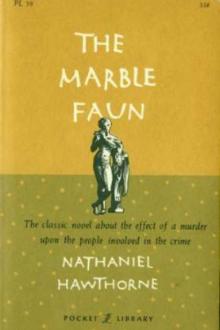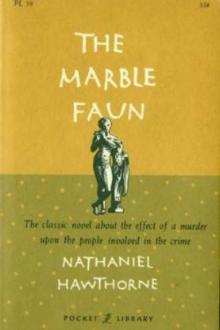The Marble Faun, vol 2 by Nathaniel Hawthorne (smallest ebook reader TXT) 📖

- Author: Nathaniel Hawthorne
- Performer: -
Book online «The Marble Faun, vol 2 by Nathaniel Hawthorne (smallest ebook reader TXT) 📖». Author Nathaniel Hawthorne
Hopeless of a good result, Kenyon gave up all preconceptions about the character of his subject, and let his hands work uncontrolled with the clay, somewhat as a spiritual medium, while holding a pen, yields it to an unseen guidance other than that of her own will. Now and then he fancied that this plan was destined to be the successful one. A skill and insight beyond his consciousness seemed occasionally to take up the task. The mystery, the miracle, of imbuing an inanimate substance with thought, feeling, and all the intangible attributes of the soul, appeared on the verge of being wrought. And now, as he flattered himself, the true image of his friend was about to emerge from the facile material, bringing with it more of Donatello’s character than the keenest observer could detect at any one moment in the face of the original Vain expectation!—some touch, whereby the artist thought to improve or hasten the result, interfered with the design of his unseen spiritual assistant, and spoilt the whole. There was still the moist, brown clay, indeed, and the features of Donatello, but without any semblance of intelligent and sympathetic life.
“The difficulty will drive me mad, I verily believe!” cried the sculptor nervously. “Look at the wretched piece of work yourself, my dear friend, and tell me whether you recognize any manner of likeness to your inner man?”
“None,” replied Donatello, speaking the simple truth. “It is like looking a stranger in the face.”
This frankly unfavorable testimony so wrought with the sensitive artist, that he fell into a passion with the stubborn image, and cared not what might happen to it thenceforward. Wielding that wonderful power which sculptors possess over moist clay, however refractory it may show itself in certain respects, he compressed, elongated, widened, and otherwise altered the features of the bust in mere recklessness, and at every change inquired of the Count whether the expression became anywise more satisfactory.
“Stop!” cried Donatello at last, catching the sculptor’s hand. “Let it remain so!” By some accidental handling of the clay, entirely independent of his own will, Kenyon had given the countenance a distorted and violent look, combining animal fierceness with intelligent hatred. Had Hilda, or had Miriam, seen the bust, with the expression which it had now assumed, they might have recognized Donatello’s face as they beheld it at that terrible moment when he held his victim over the edge of the precipice.
“What have I done?” said the sculptor, shocked at his own casual production. “It were a sin to let the clay which bears your features harden into a look like that. Cain never wore an uglier one.”
“For that very reason, let it remain!” answered the Count, who had grown pale as ashes at the aspect of his crime, thus strangely presented to him in another of the many guises under which guilt stares the criminal in the face. “Do not alter it! Chisel it, rather, in eternal marble! I will set it up in my oratory and keep it continually before my eyes. Sadder and more horrible is a face like this, alive with my own crime, than the dead skull which my forefathers handed down to me!”
But, without in the least heeding Donatello’s remonstrances, the sculptor again applied his artful fingers to the clay, and compelled the bust to dismiss the expression that had so startled them both.
“Believe me,” said he, turning his eyes upon his friend, full of grave and tender sympathy, “you know not what is requisite for your spiritual growth, seeking, as you do, to keep your soul perpetually in the unwholesome region of remorse. It was needful for you to pass through that dark valley, but it is infinitely dangerous to linger there too long; there is poison in the atmosphere, when we sit down and brood in it, instead of girding up our loins to press onward. Not despondency, not slothful anguish, is what you now require,—but effort! Has there been an unalterable evil in your young life? Then crowd it out with good, or it will lie corrupting there forever, and cause your capacity for better things to partake its noisome corruption!”
“You stir up many thoughts,” said Donatello, pressing his hand upon his brow, “but the multitude and the whirl of them make me dizzy.”
They now left the sculptor’s temporary studio, without observing that his last accidental touches, with which he hurriedly effaced the look of deadly rage, had given the bust a higher and sweeter expression than it had hitherto worn. It is to be regretted that Kenyon had not seen it; for only an artist, perhaps, can conceive the irksomeness, the irritation of brain, the depression of spirits, that resulted from his failure to satisfy himself, after so much toil and thought as he had bestowed on Donatello’s bust. In case of success, indeed, all this thoughtful toil would have been reckoned, not only as well bestowed, but as among the happiest hours of his life; whereas, deeming himself to have failed, it was just so much of life that had better never have been lived; for thus does the good or ill result of his labor throw back sunshine or gloom upon the artist’s mind. The sculptor, therefore, would have done well to glance again at his work; for here were still the features of the antique Faun, but now illuminated with a higher meaning, such as the old marble never bore.
Donatello having quitted him, Kenyon spent the rest of the day strolling about the pleasant precincts of Monte Beni, where the summer was now so far advanced that it began, indeed, to partake of the ripe wealth of autumn. Apricots had long been abundant, and had passed away, and plums and cherries along with them. But now came great, juicy pears, melting and delicious, and peaches of goodly size and tempting aspect, though cold and watery to the palate, compared with the sculptor’s rich reminiscences of that fruit in America. The purple figs had already enjoyed their day, and the white ones were luscious now. The contadini (who, by this time, knew Kenyon well) found many clusters of ripe grapes for him, in every little globe of which was included a fragrant draught of the sunny Monte Beni wine.
Unexpectedly, in a nook close by the farmhouse, he happened upon a spot where the vintage had actually commenced. A great heap of early ripened grapes had been gathered, and thrown into a mighty tub. In the middle of it stood a lusty and jolly contadino, nor stood, merely, but stamped with all his might, and danced amain; while the red juice bathed his feet, and threw its foam midway up his brown and shaggy legs. Here, then, was the very process that shows so picturesquely in Scripture and in poetry, of treading out the wine-press and dyeing the feet and garments with the crimson effusion as with the blood of a battlefield. The memory of the process does not make the Tuscan wine taste more deliciously. The contadini hospitably offered Kenyon a sample of the new liquor, that had already stood fermenting for a day or two. He had tried a similar draught, however, in years past, and was little inclined to make proof of it again; for he knew that it would be a sour and bitter juice, a wine of woe and tribulation, and that the more a man drinks of such liquor, the sorrier he is likely to be.
The scene reminded the sculptor of our New England vintages, where the big piles of golden and rosy apples lie under the orchard trees, in the mild, autumnal sunshine; and the creaking cider-mill, set in motion by a circumgyratory horse, is all a-gush with the luscious juice. To speak frankly, the cider-making is the more picturesque sight of the two, and the new, sweet cider an infinitely better drink than the ordinary, unripe Tuscan wine. Such as it is, however, the latter fills thousands upon thousands of small, flat barrels, and, still growing thinner and sharper, loses the little life it had, as wine, and becomes apotheosized as a more praiseworthy vinegar.
Yet all these vineyard scenes, and the processes connected with the culture of the grape, had a flavor of poetry about them. The toil that produces those kindly gifts of nature which are not the substance of life, but its luxury, is unlike other toil. We are inclined to fancy that it does not bend the sturdy frame and stiffen the overwrought muscles, like the labor that is devoted in sad, hard earnest to raise grain for sour bread. Certainly, the sunburnt young men and dark-cheeked, laughing girls, who weeded the rich acres of Monte Beni, might well enough have passed for inhabitants of an unsophisticated Arcadia. Later in the season, when the true vintage time should come, and the wine of Sunshine gush into the vats, it was hardly too wild a dream that Bacchus himself might revisit the haunts which he loved of old. But, alas! where now would he find the Faun with whom we see him consorting in so many an antique group?
Donatello’s remorseful anguish saddened this primitive and delightful life. Kenyon had a pain of his own, moreover, although not all a pain, in the never quiet, never satisfied yearning of his heart towards Hilda. He was authorized to use little freedom towards that shy maiden, even in his visions; so that he almost reproached himself when sometimes his imagination pictured in detail the sweet years that they might spend together, in a retreat like this. It had just that rarest quality of remoteness from the actual and ordinary world B a remoteness through which all delights might visit them freely, sifted from all troubles—which lovers so reasonably insist upon, in their ideal arrangements for a happy union. It is possible, indeed, that even Donatello’s grief and Kenyon’s pale, sunless affection lent a charm to Monte Beni, which it would not have retained amid a more abundant joyousness. The sculptor strayed amid its vineyards and orchards, its dells and tangled shrubberies, with somewhat the sensations of an adventurer who should find his way to the site of ancient Eden, and behold its loveliness through the transparency of that gloom which has been brooding over those haunts of innocence ever since the fall. Adam saw it in a brighter sunshine, but never knew the shade of Pensive beauty which Eden won from his expulsion.
It was in the decline of the afternoon that Kenyon returned from his long, musing ramble, Old Tomaso—between whom and himself for some time past there had been a mysterious understanding,—met him in the entrance hall, and drew him a little aside.
“The signorina would speak with you,” he whispered.
“In the chapel?” asked the sculptor.
“No; in the saloon beyond it,” answered the butler: “the entrance you once saw the signorina appear through it is near the altar, hidden behind the tapestry.”
Kenyon lost no time in obeying the summons.
CHAPTER XXXI THE MARBLE SALOON
In an old Tuscan villa, a chapel ordinarily makes one among the numerous apartments; though it often happens that the door is permanently closed, the key lost, and the place left to itself, in dusty sanctity, like that chamber in man’s heart where he hides his religious awe. This was very much the case with the chapel of Monte Beni. One rainy day, however, in his wanderings through the great, intricate house, Kenyon had unexpectedly found his way into it, and been impressed by its solemn aspect. The arched windows, high upward in the wall, and darkened with dust and cobweb, threw down a dim light that showed the altar, with a picture of a martyrdom above, and some tall tapers ranged before it. They had apparently been lighted, and burned an hour or two,
 Reading books romantic stories you will plunge into the world of feelings and love. Most of the time the story ends happily. Very interesting and informative to read books historical romance novels to feel the atmosphere of that time.
Reading books romantic stories you will plunge into the world of feelings and love. Most of the time the story ends happily. Very interesting and informative to read books historical romance novels to feel the atmosphere of that time.




Comments (0)